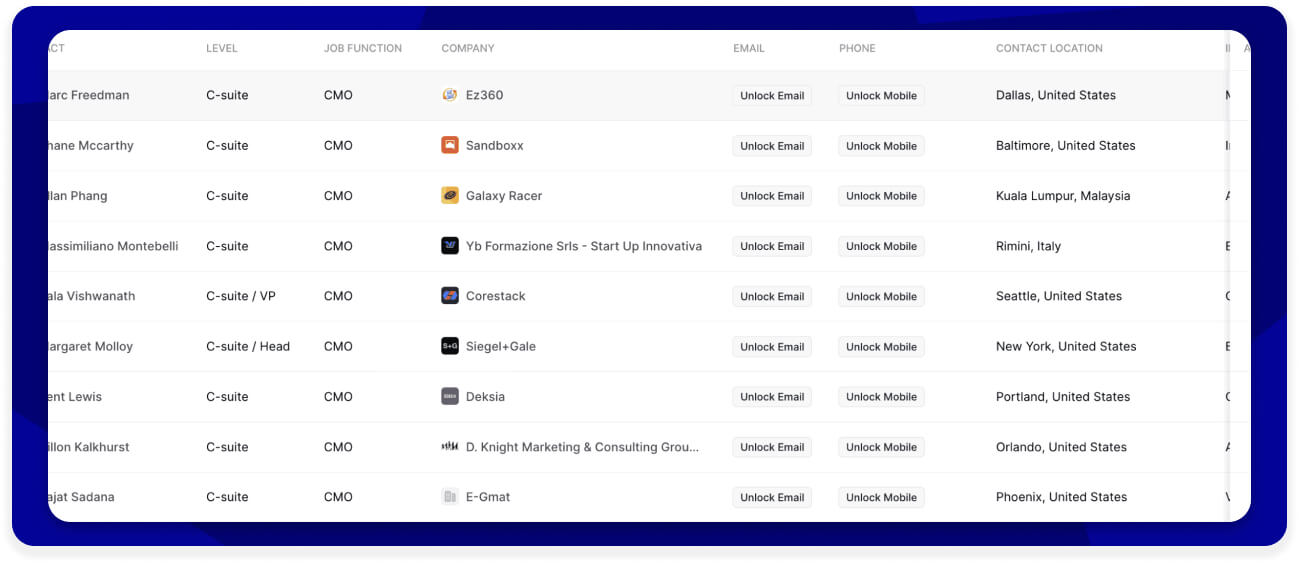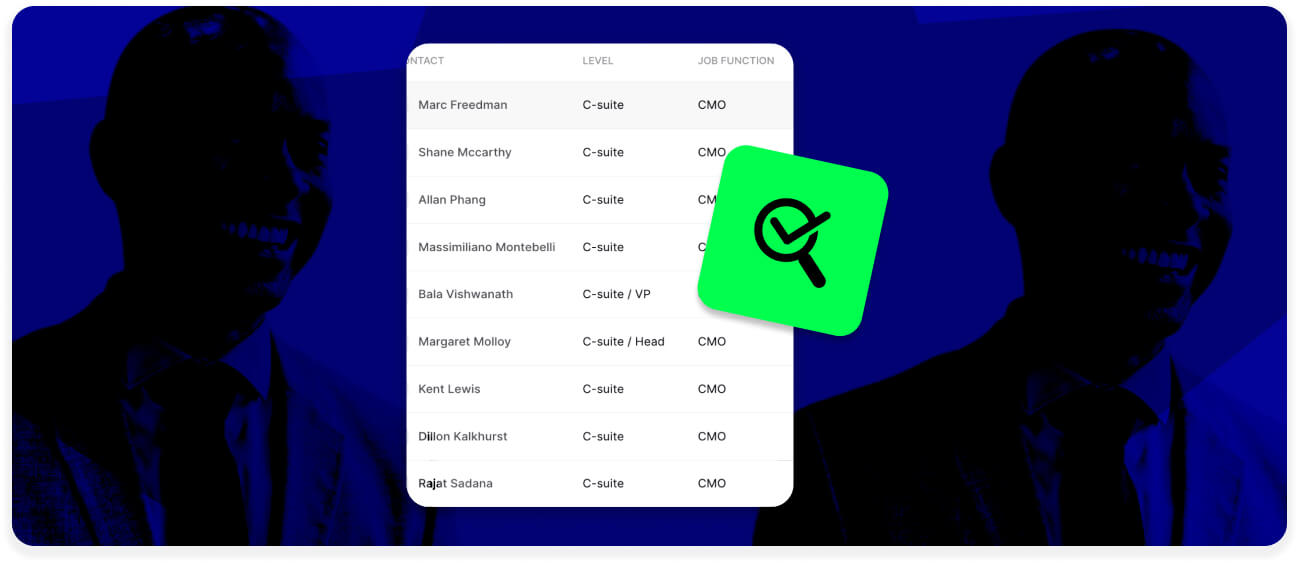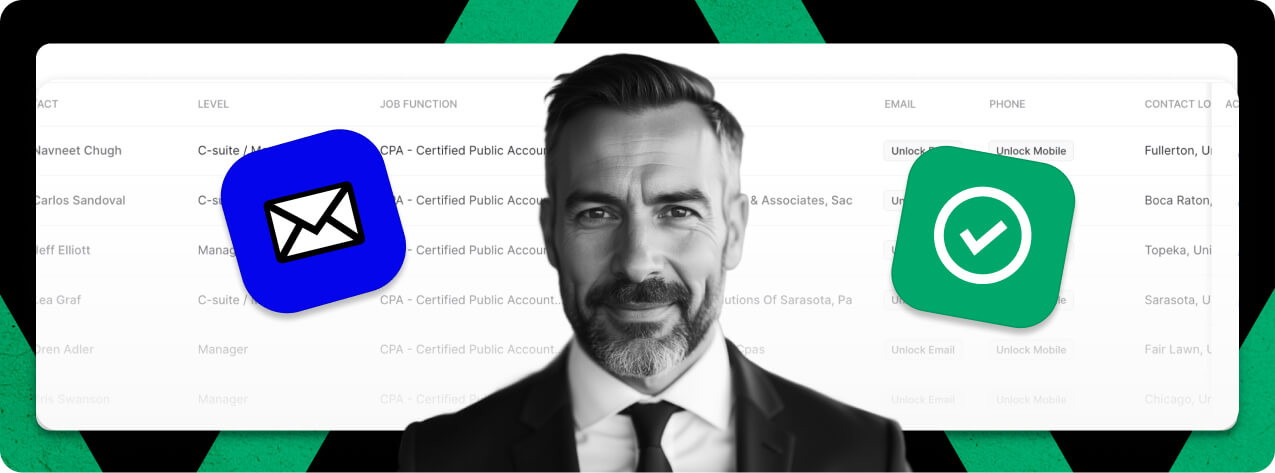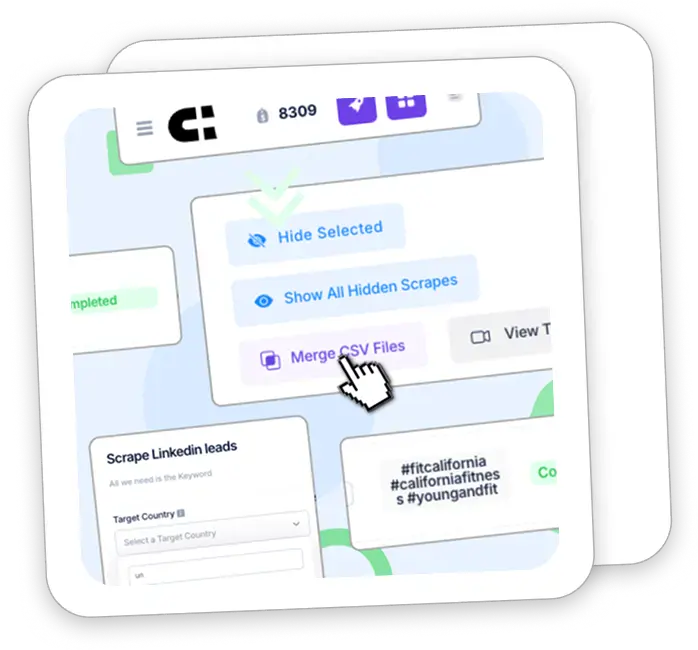Chief Marketing Officer Email List 2025
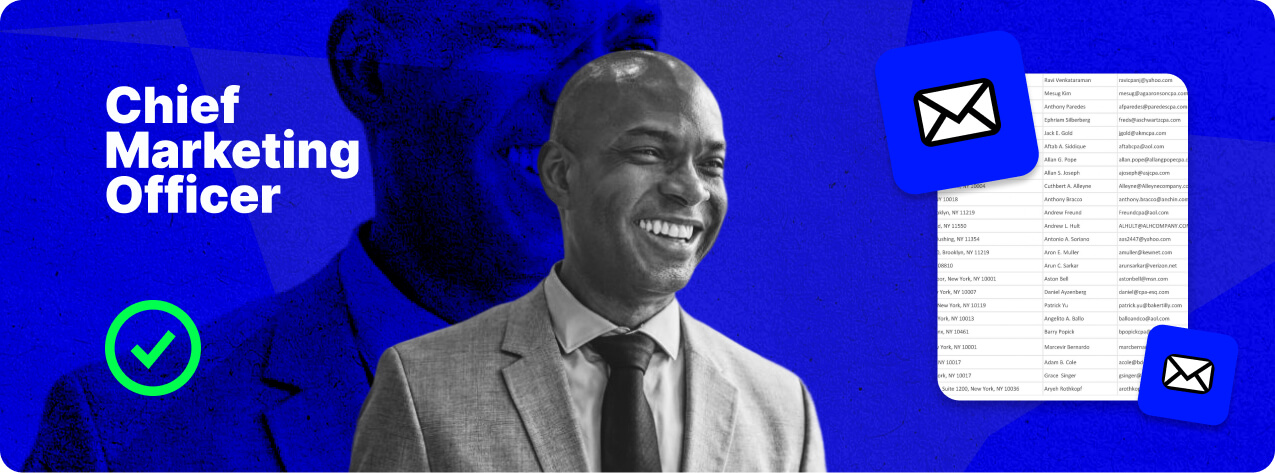
A high-quality CMO email list is one of the most powerful B2B outreach assets in 2025. These are the decision-makers responsible for budget allocation, brand strategy, software purchases, and growth initiatives across industries.
With over 64% of companies increasing their marketing budgets post-2024, the need to reach marketing leaders, fast and accurately, has never been greater.
But here’s the challenge: Most public CMO lists or lists acquired using email scrapers are:
- Outdated or generic
- Missing job titles or decision-making authority
- Skewed with mid-level marketers instead of true CMOs
- Prone to high bounce rates and compliance risk
In this guide, we’ll show you how to build, filter, or purchase a CMO email list that actually performs. From free tools like LinkedIn to premium platforms like IGLeads, we’ll break down what works in 2025. Ready? Let’s get into it.
Why CMO email lists still matter in 2025
Chief Marketing Officers aren’t just approving ad budgets, they’re shaping company strategy from the top down. In today’s digital-first economy, the CMO sits at the center of:
- Customer acquisition
- Brand positioning
- Tech stack decisions
- Revenue-driving campaigns
That influence makes them essential contacts for B2B marketers, SaaS vendors, agencies, event organizers, and data providers.
The expanding role of the CMO
Modern CMOs are expected to drive growth, not just awareness. They manage teams spanning paid media, content, CRM, partnerships, and analytics. As a result, they’re heavily involved in software selection and vendor partnerships, often with final sign-off authority.
According to Deloitte’s 2025 CMO Survey, over 71% of CMOs now oversee digital transformation initiatives within their organization. That puts them at the heart of critical decisions, from martech platforms to data compliance tools.
Why email still works
Despite the rise of social selling and AI chatbots, email remains the most effective B2B outreach channel in 2025:
- 92% of B2B buyers prefer email as their primary communication channel
- Marketing executives check email an average of 17 times per day
- Email campaigns deliver $36–$44 ROI for every dollar spent
Unlike social DMs, email lets CMOs forward your pitch internally, revisit at their own pace, or click through when timing aligns.
And unlike cold calling, it scales, without burning goodwill.
How CMO email lists support B2B marketing
An accurate, well-segmented CMO email list can open doors that would otherwise take weeks of prospecting and gatekeeper-chasing. Here’s how top-performing B2B marketers use them:
1. Targeted outreach to key decision-makers
CMOs are responsible for vendor evaluations across digital advertising, analytics, CRM, customer experience, and automation. Whether you’re selling a new SaaS platform, running an event, or offering consulting, a message in their inbox is the fastest way to a decision.
With a quality list, you can:
- Filter by industry, company size, or region
- Craft vertical-specific messages (e.g., Martech for DTC vs B2B SaaS)
- Reach the actual person responsible for buying or referring
2. Fuel for account-based marketing (ABM)
Many ABM campaigns fail because they target the company, not the person. With a segmented CMO list, you can go beyond logos and start building relationships at the executive level, especially in mid-market and enterprise deals.
- Pair email outreach with social touches and remarketing
- Send personalized case studies based on their vertical
- Map out multi-contact sequences with the CMO as your anchor
- 3. Lower cost-per-lead compared to ads
CMO-level keywords in Google Ads often cost $15–$60 per click. A well-built email list avoids that entirely, letting you reach hundreds of CMOs for the cost of one ad click.
And because you’re targeting directly, open and reply rates tend to outperform cold LinkedIn or display campaigns, especially when paired with relevant content or a short pitch.
Best ways to find a CMO email list
Finding Chief Marketing Officers can be easy, but finding real contact info with job title, company, and working email? That’s the hard part. Here are the most effective methods for sourcing quality CMO lists in 2025:
Use business directories and databases
Websites like Crunchbase, ZoomInfo, and Apollo.io offer large company databases with job titles. You can typically search by “CMO” or “Chief Marketing Officer” and filter by company size or industry.
- Pros: Structured data, export options
- Cons: Expensive plans, lead credits, outdated records
Search LinkedIn
LinkedIn is still the best real-time source of CMO titles. You can manually search by job title, industry, and location, or use tools like Sales Navigator or Chrome extensions to extract profiles.
- Pros: Updated by users, detailed targeting
- Cons: Manual extraction, may lack email addresses
Try company websites
Most B2B companies list executives on their “About” or “Team” pages. A quick Google search like Chief Marketing Officer site:[companydomain.com] can help confirm names. Combine with email format finders (e.g., [first].[last]@domain.com).
- Pros: Publicly verified info
- Cons: Time-intensive, not scalable
Use tools like IGLeads
Platforms like IGLeads scrape real-time data from Google, LinkedIn, and company sites, including names, titles, emails, and company data. Unlike static databases, this approach pulls fresh info based on your filters.
Example:
A user scraped 820 CMOs from Google and LinkedIn in under 10 minutes using IGLeads. With follow-up campaigns, they booked 7 calls in 5 days, with no ad spend.
- Pros: Fast, fresh, customizable
- Cons: Requires manual outreach, not bundled with CRM
What to check before buying a CMO mailing list
Buying a CMO email list without checking the details first can waste your budget and hurt your sender reputation. Here’s what to look for before you buy:
Is the data recent and verified?
CMO job roles change fast, so you need updated lists. The best vendors refresh their data every 30 to 60 days and run verification tools to remove invalid or bounced emails. Ask if their list includes only recent updates and whether they offer bounce-back replacement guarantees.
Can you filter by industry, company size, or geography?
A good CMO list isn’t just a name dump. You should be able to filter by B2B vs B2C, revenue, employee count, country, or even tech stack. This lets you build campaigns that match your product’s ideal customer.
What’s the average deliverability rate?
You want at least 90 percent deliverability, ideally more. Ask for recent campaign benchmarks. If the vendor doesn’t offer deliverability stats or refund credits for bad data, that’s a red flag.
Can the list be customized to your campaign?
The best lists offer custom filters, contact enrichment, and integrations. For example, you might want CMOs at SaaS companies with more than $10M ARR or those using HubSpot. A quality list provider should be able to build that for you.
How to choose a reliable CMO email list provider
Picking the right vendor makes all the difference between a successful outreach campaign and wasted spend. Here’s how to spot a trustworthy CMO email data provider.
Look for real-time data updates
CMOs are some of the fastest-churning roles in business. Top vendors update their lists at least every 30 to 60 days. Ask how often their data is refreshed, and whether they use both automated and manual verification.
Check for advanced filtering options
You should be able to narrow your list by industry, annual revenue, company size, geography, and more. Some providers also offer filters like tech stack, hiring intent, or event attendance. This kind of targeting lets you build niche segments that convert better.
Compare price vs. data quality
Cheap lists often mean outdated or scraped data with low response rates. Better providers charge more, but you’ll get cleaner, more accurate contacts with deliverability guarantees. Consider the ROI of your time and email performance, not just the upfront cost.
Read real reviews, not just testimonials
Look for case studies, third-party reviews, and in-depth customer feedback. The best vendors have users reporting open rates above 25 percent and booking calls within days of outreach.
Trust indicators: Why IGLeads is a reliable data partner
When buying a CMO email list, trust matters. At IGLeads, we prioritize compliance, accuracy, and transparency across every dataset. Here’s what sets us apart:
- GDPR and CAN-SPAM compliant – All data is sourced from public, B2B-safe sources and enriched using compliant practices.
- Updated regularly – Our CMO database is refreshed every 30 to 60 days to maintain accuracy and remove outdated contacts.
- Secure and private – We follow ISO-aligned security practices for data handling, platform access, and export protocols.
- Trusted by thousands of users – Growth marketers, SaaS founders, and agencies rely on IGLeads to find decision-makers without the fluff or inflated pricing.
“We built a 900-contact campaign in 15 minutes using IGLeads. Within 3 days we had 14 replies and 3 qualified calls.” – Director of Growth, B2B SaaS
“The filters let us pull CMOs from retail, SaaS, and financial services. Open rates are consistently 30%+.” – Agency Lead, Demand Gen
CMO email list use cases
Once you’ve built or bought a CMO email list, the next step is putting it to work. These contacts aren’t just names in a spreadsheet, they’re high-level decision-makers who can influence product adoption, marketing partnerships, and budget allocation.
How marketers use CMO email lists in 2025
Most teams integrate CMO contact data into multichannel strategies, often combining email outreach with LinkedIn ads, custom landing pages, or phone follow-ups. The goal is to establish relevance quickly and offer a clear value proposition.
For example:
-
A marketing automation platform might send a personalized demo invite highlighting pain points CMOs face with attribution.
-
An events company might use email to pitch CMOs on speaking opportunities or sponsorship packages for industry conferences.
Success here depends on personalization and timing. Your subject line and first sentence need to show you understand their role, and offer a solution, not just a sales pitch.
Top industries targeting CMOs via email
The most common verticals using CMO email databases include:
- SaaS and martech companies promoting CRM, AI tools, analytics, or email automation
- Media and event companies selling sponsorships, ad space, or webinar visibility
- Agencies and consultants offering strategy, branding, or growth services
- Recruitment and executive search firms seeking candidates for CMO-level roles
- Data and research platforms providing customer insights or marketing intelligence
These companies rely on reaching CMOs directly, bypassing lower-level gatekeepers to secure faster decisions.
Examples of successful CMO email campaigns
Some of the highest-performing campaigns share a few traits:
- Clear personalization by industry and company size
- Brief, visual emails with one CTA
- Offers like a free audit, playbook, or demo tailored to their current strategy
Examples:
- A martech startup generated 17 calls from 300 CMO contacts using a 2-line email offering a no-pitch teardown of their existing funnel.
- An agency targeting DTC brands used IGLeads to source 1,200 CMOs in fashion and cosmetics. Open rate was 33%, and two retainers were signed within a week.
Done right, these email campaigns lead to real conversations, and long-term relationships.
Performance and ROI
A CMO email list can be one of the most valuable assets in your outbound strategy, but only if you measure results and optimize consistently. Here’s how to evaluate and improve performance in 2025.
What’s a good open and click rate for CMO email campaigns?
CMOs are notoriously selective with their attention. That’s why campaign benchmarks for this audience skew a bit lower than general B2B metrics, but still deliver strong ROI when done right.
- Open rate: Aim for 20 to 28 percent, especially if using a personalized sender address
- Click-through rate (CTR): 2 to 4 percent is a solid target for CMO audiences
- Reply rate: 1 to 3 percent is strong when pitching consulting, SaaS, or partnerships
CMOs tend to open emails during morning hours, especially Tuesday through Thursday. Avoid sending late in the week or during marketing-heavy months like January and September.
How to A/B test subject lines for marketing executives
Subject line testing is essential when emailing CMOs. Consider testing:
- Personalization vs. non-personalized: Using a company name or industry keyword often boosts open rates
- Question vs. statement: Questions tend to outperform statements by 12 to 18 percent
- Length: 3 to 6 words tends to perform best in inbox previews
Examples to test:
- “Growth strategy for {Company}”
- “Are you hiring marketers this quarter?”
- “What CMOs are missing about conversion cost”
Track open rates and replies to see which subject lines resonate most with your audience.
Improving ROI through targeting and timing
CMOs don’t respond well to generic mass emails. These tips can help improve results:
- Segment by industry, headcount, or funding stage
- Use recent news (like product launches or funding announcements) as outreach hooks
- Send short, direct emails with one link or CTA
Above all, offer something of value, a trend report, audit, or insight they can’t find elsewhere. That’s what earns replies from busy execs.
Why IGLeads is the smarter way to reach CMOs
Chief Marketing Officers are high-value, high-barrier prospects, and if you’re relying on generic B2B lists or outdated databases, you’re already falling behind. Success with CMO email outreach depends on two things: the quality of your data and the relevance of your message.
That’s where IGLeads stands out.
Instead of paying for overpriced contacts or manually scraping LinkedIn, IGLeads lets you instantly access up-to-date CMO email lists filtered by:
- Industry
- Company size
- Location
- Keywords and job titles
You get clean, exportable data sourced from real-time scraping, without the guesswork or credit systems. Combine that with personalized outreach — think tailored messaging based on industry pain points, and suddenly, you’re not just getting replies, you’re booking qualified meetings.
Find executive and C-suite email lists
- Get Fresh Chief Revenue Officers Email List 2025
- Get Fresh Chief Sales Officer Email List 2025
- Get Fresh COO Email List 2025
- Get Fresh Chief Information Officers Email List 2025
- Email Extractor Ultimate Guide 2025
- CFO Email List – Get Targeted CFO Contacts in 2025
- Get Fresh CEO Email List 2025
Explore more lead generation strategies and tools
- B2B Lead Generation Solutions – Guide for 2025
- How to Build a High-Quality B2B Email List for Outbound Marketing
- Buy Email Lists for Marketing in 2025: Complete Guide to Business Leads
- Why Scrape Google Maps? Use Cases for Sales, Marketing & SEO
- B2C Lead Generation: The 2025 Playbook
- 15 Best Lead Generation Companies for 2025
- Best B2B email list providers in 2025
- Top Lead Generation Agencies Compared (2025)
- 18 Best B2B Lead Generation softwares in 2025
- Lead Generation Guide: Strategies & Tools for 2025
Frequently Asked Questions
A quality CMO email list should be updated every 30 to 90 days. This ensures the contact data reflects current job roles, companies, and verified email addresses. Since CMOs frequently change roles or titles, using outdated lists can quickly lead to high bounce rates and lower campaign performance.
A strong deliverability rate for a CMO-focused email list is 90 percent or higher. Anything below that indicates poor data quality or lack of proper verification. Top-tier providers will offer deliverability guarantees and replacement credits for bounced emails.
Yes. The best providers allow you to filter CMO data by variables like company size, industry, revenue, location, or even technology stack. These filters help you create hyper-targeted campaigns and improve conversion rates by sending relevant offers to the right audience.
Reputable email list providers, including IGLeads, source data from publicly available B2B directories and comply with both GDPR and CAN-SPAM regulations. That said, you are still responsible for following compliant outreach practices, including opt-out links and clear identification.
A high-quality list should include the contact’s full name, job title, company name, email address, phone number, company size, industry, and location. Some premium lists also include social profiles and tech stack data when available.
To boost ROI, personalize your messaging based on the recipient’s role, challenges, or industry. Use custom subject lines, short copy, and a clear value proposition. Split-test campaigns regularly and avoid using the same generic message for every contact.
SaaS companies, marketing agencies, ad tech providers, recruitment firms, and enterprise vendors benefit the most. These businesses often sell tools, services, or platforms that directly align with a CMO’s strategic priorities, including brand growth, customer acquisition, and ROI tracking.
